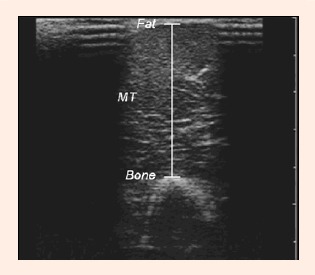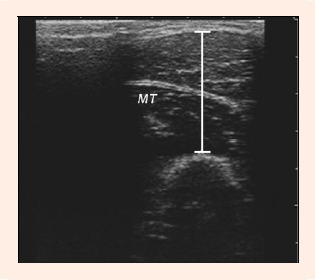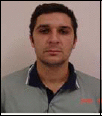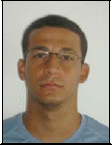Abstract
Traditional exercise order dictates large muscle group or multijoint exercises should be performed before small muscle group or single joint exercises. The purpose of this study was to examine the influence of exercise order on strength and muscle thickness (MT) in untrained men after 12 weeks of linear periodized resistance training. The participants were randomly assigned into three groups. One group began with large and progressed toward small muscle group exercises (LG-SM) while another started with small and advanced to large muscle group exercises (SM-LG). The exercise order for LG-SM was bench press (BP), lat pull-down (LPD), triceps extension (TE), and biceps curl (BC). The order for the SM-LG was BC, TE, LPD, and BP. The third group served as a control group (CG). Training frequency was two sessions/week with at least 72 hours between sessions. One repetition maximum (1RM) for all exercises, biceps and triceps MT (assessed by ultrasound techniques) were collected at baseline and after 12 weeks. After 12 weeks, all exercises for both training groups presented significant 1RM strength gains when compared to CG with exception of BC in LG-SM. Between baseline and post training, all exercises for both training groups presented significant strength gains with exception of BC in LG-SM and BP in SM-LG. Triceps MT for both training groups were significantly higher when compared to the CG, but with no significant differences between them (p > 0.05). Significant differences in MT from pre- to post-training were found only for the SM-LG group (p < 0.05), while the biceps MT presented significant differences only between LG-SM and CG (p < 0.05), Effect size data demonstrated differences in 1RM and triceps MT based on exercise order. In conclusion, if an exercise is important for specific training goals, it should be performed at the beginning of the training session, whether or not it is a large or a small muscle group exercise.
Key points.
The two linear periodized resistance training programs utilized promotes strength and muscle volume gains in untrained men.
Exercise order may be particularly important to improve strength during 12 weeks of linear periodized resistance training.
If an exercise is important for the training goals of a program, then it should be placed at the beginning of the training session, whether or not it is a large or a small muscle group exercise.
Key words: Muscle strength, weight lifting, exercise, physical fitness.
Introduction
Traditional exercise order dictates large muscle group or multijoint exercises should be performed before small muscle group or single joint exercises, because this exercise sequence may result in the greatest long-term strength gains (American College of Sports Medicine, 2002; 2009; Kraemer and Fleck, 2007; Sforzo and Touey, 1996). Recently Simão et al. (2005; 2007) observed that performing either large or small muscle group exercises at the end of a resistance training sequence resulted in significantly fewer repetitions compared to when the same exercises were performed early in the training session. With results quite similar in regards to the number of repetitions, Gentil et al., 2007 recommended if the strength and conditioning professional wants to maximize the athlete’s performance in one specific resistance exercise, this exercise should be placed at the beginning of the resistance training session. In contrast, Spreuwenberg et al., 2006 showed exercise order can promote a higher power development when the exercise is placed at the end of a single training session despite reductions in total work and number of repetitions performed per set.
A recent study conducted by Farinatti et al., 2009 showed the exercise order had no effect on the total work, overall VO2, or energy expenditure associated with exercise sequences composed of the same exercises for the upper body. However, the last exercise in a given sequence exhibited a higher VO2 in the rest intervals between sets, which may reflect the accumulation of fatigue from previous exercises. Thus, although exercise order does result in a decrease in the number of repetitions of sets performed to failure for exercises performed later in a training session, it does not seem to affect the total training volume, VO2, or energetic expenditure. Furthermore, Bellezza et al., 2009 suggested that small to large exercise order may have beneficial physiological and psychological outcomes and potentially influence exercise adherence in initial training stages.
To the author’s knowledge, methodological training studies manipulating exercise order and the investigation of its influence on strength and muscle thickness (MT) gains are still lacking in the literature. A previous study from our laboratory (Dias et al., 2010) examined the influence of exercise order on strength in untrained young men after eight weeks of training. One group began with large and progressed toward small muscle group exercises while another started with small and advanced to large muscle group exercises. Both groups resulted in significant increases in one repetition maximum strength (1RM) compared to the control group. However, the small muscle group exercises revealed significant higher strength gains when placed first, demonstrating the exercise order for small muscle exercises may be particularly important during the initial stages of resistance training in untrained young men. Therefore, the purpose of the present study was to examine the influence of exercise order of a resistance training session on 1RM strength and biceps and triceps MT during 12 weeks of linear periodized training in untrained men. Based on previous research, we hypothesized the placement of small muscle group exercises at the end of a training session would negatively affect strength and MT gains of these muscles when compared to performing these exercises in the beginning of the training session.
Methods
Subjects
Thirty-one men from the Brazilian Navy Sergeants School were randomly assigned into three groups. The first group trained in sessions beginning with large muscle group exercises and progressing toward small muscle group exercises (LG-SM, n = 9). The second group trained using the exact opposite exercise order beginning with small muscle group exercises progressing toward large muscle group exercises (SM-LG, n = 13). The third group served as a control group (CG, n = 9) and continued performing regular military physical activity program during the 12 weeks period, but not the resistance training program. There were no significant differences (p > 0.05) between groups in height, body mass, or body fat percentage prior to training (Table 1). Study inclusion criteria were the following characteristics for all participants: a) were physically active, but had not practiced resistance training for at least six months prior to the start of the study; b) not performing any type of regular physical activity for the duration of the study other than the prescribed resistance training and regular military physical activity program; c) did not have any functional limitations for the resistance training or the performance of the 1RM tests; d) not presenting any medical condition that could influence the training program; and e) did not use any nutrional supplementation (the military diet was the same for all the participants). All participants read and signed an informed consent form after being informed of the testing and training procedures to be performed during the study. The experimental procedures were approved by the Ethics Committee of Rio de Janeiro Federal University.
Table 1.
Baseline anthropometric characteristics. Data are means (±SD).
| Group | Age (years) | Height (m) | Weight (kg) | Body fat (%) |
|---|---|---|---|---|
| LG-SM (n =9) | 29.9 (1.9) | 1.72 (.07) | 79.9 (10.6) | 13.8 (4.2) |
| SM-LG (n=13) | 29.1 (2.9) | 1.76 (.07) | 78.4 (9.1) | 13.6 (3.3) |
| CG (n =9) | 25.9 (3.6) | 1.71 (.06) | 73.9 (9.9) | 15.3 (6.9) |
Anthropometric measurements
Anthropometric measurements consisted of height, body mass, body fat (Jackson and Pollock, 1978), and strength (1RM), as well as biceps and triceps MT by ultrasound techniques. Anthropometrics measurements were assessed only at baseline, for group descriptions. Biceps and triceps MT and 1RM tests for all exercises were assessed at baseline and after 12 weeks of training, during the same time of day.
Muscle thickness assessment
The MT was assessed using an ultrasound (US) apparatus (EUB-405, Hitachi, Japan) with an electronic linear array probe of 7.5 MHz wave frequency. Measurements were performed at 60% of the right arm length (Miyatani et al., 2004). Elbow flexors (Figure 1) and extensors (Figure 2) MT were considered as the distance between the interfaces of the muscle tissue, from the subcutaneous fat to the bone (Fukunaga et al., 2001; Miyatani et al., 2004).
Figure 1.

Muscle thickness (MT) of elbow flexors.
Figure 2.

Muscle thickness (MT) of elbow extensors.
Strength testing
After two weeks of a resistance training familiarization period, all participants completed three familiarization sessions of the 1RM test protocol with 48 to 72 hours between sessions. The 1RM tests were then performed on two non-consecutive days for all exercises using a counterbalanced order. On day one, the first 1RM tests were performed, and then after 48 hours the 1RM tests were repeated to determine test-retest reliability. The heaviest load achieved on either of the test days was considered the pre-training 1RM. No exercise was allowed in the 48-hour period between 1RM tests, so as not to interfere with the test-retest reliability results. The 1RM testing protocol has been previously described elsewhere (Simão et al., 2007). To minimize errors during 1RM testing, the following strategies were adopted: a) standardized instructions concerning the testing procedure were given to participants before the test; b) participants received standardized instructions on exercise technique; c) verbal encouragement was provided during the testing procedure; d) the mass of all weights and bars used were determined using a precision scale. The 1RM was determined in fewer than five attempts with a rest interval of five minutes between 1RM attempts while 10 minutes was allowed before the start of the test of the next exercise. The highest load achieved in both days was considered the 1RM. Following 12 weeks of training, the 1RM test was performed in the same manner as the pre-training test in order to compare the strength gains in those exercises.
Experimental procedure
Prior to the 12-week training program, participants were randomly assigned to three groups (LG-SM, SM-LG, and CG). The exercise order for LG-SM was barbell bench press (BP), machine lat-pull down (LPD), machine triceps extension (TE), and free weight standing biceps curl with a straight bar (BC). The exercise order for SM-LG was BC, TE, LPD, and BP. The CG did not take part in the resistance training program. A linear periodized resistance training program was used. From the first to the fourth week, four sets of each exercise were performed with light intensity (12 to 15 repetitions) with one minute of rest between the sets. From the fifth to the eighth week, three sets of each exercise were performed with moderate intensity (eight to 10 repetitions) with two minutes of rest between the sets. From the ninth to the twelfth week two sets of each exercise were performed with high intensity (three to five repetitions) with three minutes of rest between the sets. During the exercise sessions, participants were verbally encouraged to perform all sets to concentric failure and the same definitions of a complete range of motion used during the 1RM testing were used to define completion of a successful repetition. There was no attempt to control the velocity of the repetitions performed. Whenever an individual could perform more than the prescribed number of repetitions for all sets of a given exercise, the resistance intensity for that particular exercise was increased. An experienced strength and conditioning professional supervised all training sessions. Frequency of the training program was two sessions per week with at least 72 hours of rest between sessions. A total of 24 sessions was performed along the 12-week training period with all sessions occurring between seven and eight a.m. Prior to each training session, the participants performed a specific warm up, consisting of 20 repetitions with approximately 50% of the resistance used in the first exercise of the training session. Adherence to the program was 100.0% for all the groups.
Statistical analyses
The total work performed by LG-SM and SM-LG were calculated multiplying the number of sessions by the number of sets, repetitions and resistance load (session × sets × repetitions × load). Intra-class correlation coefficients (ICC) were used to determine 1RM test-retest reliability. The ICC method was used based on repeated measurements of maximal strength. T-tests were used to analyze for differences between 1RM test and retest, pre- and post-training, and between the total work (session × sets × repetitions × load) in both training programs. Coefficient of variation (CV) was used to calculate within-participant variation (CV% = [standard deviation ÷ mean] × 100) (Levinger et al., 2009). The statistical analysis was initially done by the Shapiro-Wilk normality test and by the homocedasticity test (Bartlett criterion). All variables presented normal distribution and homocedasticity. Two-way ANOVAs (time [baseline vs. post-training] × group [SM-LG vs. LG-SM vs. control]) were used to analyze for differences among the groups for 1RM load and kilogram of body mass (1RM load/body mass) for each exercise, and for biceps and triceps MT. When appropriate, follow-up analyses were performed using Fisher post hoc tests. The scale proposed by Cohen, 1988 was used for classification of the effect size magnitude (the difference between pretest and post-test scores divided by the pre-test standard deviation) of 1RM strength and MT data. An alpha level of p < 0.05 was considered statistically significant for all comparisons. Statistica version 7.0 (Statsoft, Inc., Tulsa, OK) statistical software was used for all statistical analyses.
Results
There was no difference between total work performed by LG-SM (430893 ± 11041 kg) and SM-LG (360827 ± 14407 kg). The 1RM test-retest reliability showed high ICC at baseline (BP, r = 0.94, SEM = 3.11; LPD, r = 0.98, SEM = 0.54; TE, r = 0.96, SEM = 1.25; BC, r = 0.96, SEM = 0.67), and after 12 weeks of training (BP, r = 0.96, SEM = 3.16; LPD, r = 0.98, SEM = 0.44; TE, r = 0.96, SEM = 2.81; BC, r = 0.98, SEM = 0.62). There were no differences (p > 0.05) among groups in MT or 1RM measurements at baseline (Tables 2 and Tables 3). There were no significant differences (p > 0.05) in 1RM between training groups for the selected exercises after 12 weeks of training (Table 2). However, when compared to CG, all exercises for both training groups presented significant 1RM strength gains with exception of BC in LG-SM (Table 2). Furthermore, between baseline and after 12 weeks of training, all exercises for both training groups presented significant strength gains with exception of BC in LG-SM and BP in SM-LG (Table 2). The analysis of 1RM loads per kilogram of body mass normalization demonstrated significant 1RM strength gains between baseline and after 12 weeks of training for all exercises. In addition, after 12 weeks of training, the normalized 1RM loads of BP for both training groups were significantly different from CG, while normalized 1RM loads for TE and BC were significant different only between SM-LG and CG (Table 2). Tables 3 show the triceps and biceps MT at baseline and after 12 weeks of training. Triceps MT for both training groups were significantly higher when compared to the CG at 12 weeks, and between pre- and post-training for SM-LG (p < 0.05), while the biceps MT presented significant differences only between LG-SM and CG at 12 weeks.
Table 2.
1RM (kg) tests, kilogram of body mass and CV at baseline and after 12 weeks of resistance training. Data are means (±SD).
| Bench press | Lat pull down | Triceps extension | Biceps curl | ||||||
|---|---|---|---|---|---|---|---|---|---|
| Group | Baseline | 12 weeks | Baseline | 12 weeks | Baseline | 12 weeks | Baseline | 12 weeks | |
| LG-SM (n=9) | 1RM | 79.3 (13.3) | 86.4 (12.1)*† | 88.8 (16.0) | 99.4 (10.8)*† | 75.6 (18.6) | 90.9 (13.8)*† | 33.3 (6.3) | 38.3 (6.3) |
| 1RM/BM | 1.0 (.2) | 1.1 (.2)*† | 1.10 (.09) | 1.26 (.22)* | .95 (.21) | 1.15 (.24)* | .42 (.09) | .49 (.11)* | |
| CV (%) | 18.74 | 21.07 | 20.89 | 17.70 | 22.43 | 20.91 | 21.52 | 22.42 | |
|
SM-LG
(n=13) |
1RM | 70.3 (13.7) | 78.0 (14.9)† | 86.7 (9.4) | 92.1 (10.3)*† | 73.3 (13.0) | 92.3 (14.0)*† | 32.6 (4.9) | 38.1 (4.5)*† |
| 1RM/BM | .91 (.21) | 1.0 (.3)*† | 1.12 (.21) | 1.19 (.22)* | .94 (.15) | 1.19 (.24)*† | .42 (.10) | .57 (.28)*† | |
| CV (%) | 23.25 | 26.68 | 18.67 | 18.47 | 15.62 | 18.87 | 23.14 | 19.11 | |
|
CG
(n=9) |
1RM | 71.6 (8.9) | 69.5 (7.2) | 86.6 (10.4) | 85.2 (8.7) | 34.0 (4.1) | 32.1 (3.0) | 34.7 (2.9) | 34.2 (3.1) |
| 1RM/BM | .98 (.18) | .99 (.19) | 1.19 (.23) | 1.21 (.19) | .47 (.08) | .45 (.08) | .48 (.09) | .49 (.09) | |
| CV (%) | 13.0 | 12.7 | 12.7 | 11.5 | 13.0 | 11.2 | 8.9 | 11.2 | |
1RM/BM =1RM (kg) per kg of body mass.
* significant difference from baseline;
† significant difference from control group.
Table 3.
Triceps and biceps muscle thickness across 12 weeks of resistance training (mean ± SD). Values are expressed in cm. Data are means (±SD).
| Group | Triceps muscle thickness | Biceps muscle thickness | ||
|---|---|---|---|---|
| Baseline | 12 weeks | Baseline | 12 weeks | |
| LG-SM (n=9) | 3.88 (.45) | 3.88 (.42) † | 3.66 (.64) | 3.88 (.42) † |
| SM-LG (n=13) | 3.47 (.59) | 3.75 (.45) *† | 3.67 (.50) | 3.80 (.40) |
| CG (n=9) | 3.25 (.48) | 3.19 (.39) | 3.66 (.46) | 3.65 (.37) |
* significant difference to baseline;
† significant difference to control group.
Effect size data (Table 4) demonstrated that differences in strength were exhibited based on exercise order. While both training groups demonstrated greater strength improvements than the CG, which actually decreased in strength, TE strength increased to a greater magnitude in the SM-LG group as compared to the LG-SM, 2.07 versus 0.75 respectively. In BP, the same magnitude was observed for both training groups while in LPD, the LG-SM group showed lower strength increases. The opposite occurred in BC, where modest strength increases was observed in SM-LG. Triceps MT effect size increased only in the SM-LG group (Table 4).
Table 4.
1RM tests and muscle thickness effect sizes and magnitudes across 12 weeks of resistance training.
| Bench press | Lat pull down | Triceps extension | Biceps curl | Triceps MV | Biceps MV | ||
|---|---|---|---|---|---|---|---|
| Group | 12 weeks | 12 weeks | 12 weeks | 12 weeks | 12 weeks | 12 weeks | |
| LG-SM (n=9) | Effect size Magnitude |
.54 moderate |
.78 moderate |
.75 moderate |
.82 large |
.00 trivial |
.34 small |
| SM-LG (n=13) | Effect size Magnitude |
.56 moderate |
.58 moderate |
2.07 large |
1.11 large |
.47 small |
.26 small |
| CG (n=9) | Effect size Magnitude |
-.23 trivial |
-.13 trivial |
-.17 trivial |
-.46 trivial |
-.12 trivial |
.07 trivial |
Discussion
The purpose of this study was to examine the effects of exercise order on muscle strength and MT. The key finding of the present study is that the exercises placed at the end of the training sequences for both training groups (BP in SM-LG and BC in LG-SM) did not present significant 1RM strength gains between baseline and 12 weeks. In addition, when compared to CG, all exercises for both training groups presented significant 1RM strength gains with exception of BC in LG-SM. These results confirm our initial hypothesis, showing that the strength gains of the last exercises of both sequences were negatively affected. However, muscle accretion did not reproduce the observed strength responses between the different exercise orders after 12 weeks of linear periodized resistance training in untrained men and little can be drawn from these conflicting data with regards to muscle hypertrophy. The absolute strength gains and muscle accretion did not present statistical differences between training groups. However, it is important to examine treatment effects independent of statistical probability, especially in small sample sizes (Rhea, 2004). The effect size calculations present interesting alterations based on exercise order. The only exercise in which the SM-LG group demonstrated greater magnitudes of 1RM strength gains was the triceps extension. Conversely, the lat pull down showed modest 1RM strength gains in the LG-SM while the opposite occurred with the biceps curl in the SM-LG. Triceps MT effect size increased only in the SM-LG group, while the biceps MT effect size displayed similar improvements between training groups. Thus, confirming our initial hypothesis, the 1RM strength gains results, such as the 1RM and MT effect size data, suggest that an exercise order should begin with exercises that are particularly important for the training goals of a program, whether or not it is a large or a small muscle group exercise. However, additional research would be needed for further evaluation of this variable.
Only one study has looked at the chronic effects of different exercise orders thus far. Dias et al., 2010 examined the influence of exercise order on strength in untrained young men after eight weeks of training. One group began with large and progressed toward small muscle group exercises (G1), another started with small muscle group exercises and advanced to large muscle group exercises (G2), and the third group did not exercise and served as a control group (CG). The exercise order for the G1 was BP, LPD, seated machine shoulder press (SP), BC, and TE. The order for the G2 was TE, BC, SP, LPD, and BP. Training procedures were three sets of 6- to 12-RM for each exercise, and a frequency of three sessions per week with at least 48 hours of rest between sessions for a total of 24 sessions in the eight-week period. The results revealed no significant differences in 1RM gains between G1 and G2 in large muscle group exercises (BP, SP, and LPD). However, significant differences were found in small muscle group exercises (BC and TE) between the different exercise sequences. Their aforementioned study suggests exercise order may be particularly important during the initial stages of resistance training in untrained young men, mainly in small muscle group exercises. In contrast with the findings of Dias et al., 2010, we did not find differences in the present study between LG-SM and SM-LG after 12 weeks of resistance training. Nevertheless, between baseline and after 12 weeks of training, all exercises for both training groups presented significant strength gains with the exception of BC in LG-SM and BP in SM-LG, the last exercises of the sequences. Based upon these results, we believe exercise order may be particularly important during the initial stages of resistance training in untrained men. However, these results seem to be independent of the size of the muscle group involved in the exercises.
Previous studies from our research group (Simão et al., 2005; 2007) are in agreement with these results and suggest whenever an exercise is performed last in an exercise sequence or training session, performance of that particular exercise may be negatively affected. This is true whether the exercise involves large or small muscle groups. Both studies by Simão et al. (2005; 2007) indicated an exercise should be performed early in a resistance training session if the exercise is important to meet the training goals of a resistance training program. Simão et al., 2005 investigated the influence of different exercise orders on the number of repetitions performed in a group composed of both men and women with at least two years of recreational resistance training experience. The exercise sessions consisted of performing three sets of each exercise with a resistance of 10RM and two-minute rest periods between sets and exercises. One session began with exercises of the large muscle group and progressed to exercises of the small muscle group (BP, LPD, SP, BC, and TE), whereas the other session was performed with the opposite exercise sequence (TE, BC, SP, LPD, and BP). The results demonstrated performing either large or small group exercises for the upper-body at the end of an exercise sequence resulted in significantly fewer repetitions compared to when the same exercises were performed early in an exercise sequence. A more recent study from Simão et al., 2007 suggested a similar occurrence of a decrease in the total number of repetitions performed when both upper and lower-body exercises were performed in the same exercise sequence by 23 women with a minimum of two years of resistance training experience. Data were collected in two phases: determination of a 1RM and execution of three sets, with two-minute rest intervals between sets and exercises, using 80% of 1RM until fatigue in two exercise sequences of opposite order. In agreement with previous results (Simão et al., 2005), this study (Simão et al., 2007) demonstrated an exercise performed last in a training session is negatively affected in an acute manner whether the exercise involves large or small muscle groups.
The fact that the different exercise orders did not increase strength and MT significantly different between the training groups, throughout the course of the study, was unexpected. Nevertheless, it should be noted both training groups revealed increases in strength over the course (12 weeks) of the training period. Table 2 displays the improvements in 1RM by each group in all exercises independent of exercise order sequence. Although the 24 training sessions used in this study did not demonstrate any significant differences between training groups, the gains evidently demonstrated the training stimulus was adequate. Another interesting point to observe, in Table 4 were the 1RM tests effect sizes and magnitudes across 12 weeks of resistance training in both sequences. The 1RM effect size data showed larger strength development in smaller muscles for the SM-LG group (TE: 2.07; BC: 1.11) versus LG-SM (TE: 0.75; BC: 0.82). Furthermore, triceps MT effect size showed small treatment effect only for SM-LG group, whereas the other group’s MT measurements were none or even decreased. These data agree with the previously described results by Dias et al., 2010, suggesting the exercise important for the training goals should be placed at the beginning of the training session, independently of the size of the muscle groups involved.
Conclusion
The current study examined the chronic effects of different exercise orders on untrained males. Chronic adaptations to subtle variations in training stimuli may not be observed in novice individuals and/or in the time frame used in the current protocol. Thus, future studies should investigate chronic effects of exercise order, as well as other aspects associated with resistance training, in more experienced trainees and perhaps for a longer period. Based on the 1RM strength gains and effect size results of the current study, in addition to reviewing other studies examining this issue, it appears exercises that are particularly important for the training goals of a program should be placed at the beginning of the training session, whether or not it is a large or a small muscle group exercise.
Acknowledgements
Dr. Roberto Simão would like to thank the Brazilian National Board for Scientific and Technological Development (CNPq) for the research grant support.
Biographies

Roberto Simão
Employment
Professor of the Physical Education Post-Graduation Program, Physical Education and Sports School, Federal University of Rio de Janeiro, Rio de Janeiro, Brazil.
Degree
PhD.
Research interests
Resistance training and physiopathology and resistance training variables (e. g. rest interval, exercise order).
E-mail: robertosimao@ufrj.br

Juliano Spineti
Employment
Student of the Physical Education Post-Graduation Program, Physical Education and Sports School, Federal University of Rio de Janeiro, Rio de Janeiro, Brazil.
Degree
BSc, MSc student.
Research interests
Resistance training variables.
E-mail: juliano.spineti@hotmail.com

Belmiro F. de Salles
Employment
Student of the Physical Education Post-Graduation Program, Physical Education and Sports School, Federal University of Rio de Janeiro, Rio de Janeiro, Brazil.
Degree
BSc, MSc, PhD student.
Research interests
Resistance training and physiopathology and resistance training variables.
E-mail: belmirosalles500@hotmail.com

Liliam F. Oliveira
Employment
Professor of the Physical Education Post-Graduation Program, Physical Education and Sports School, Federal University of Rio de Janeiro, Rio de Janeiro, Brazil.
Degree
PhD.
Research interests
Biomechanics, muscle modelling, EMG.
E-mail: liliam@eefd.ufrj.br

Thiago Matta
Employment
Student of the Physical Education Post-Graduation Program, Physical Education and Sports School, Federal University of Rio de Janeiro, Rio de Janeiro, Brazil.
Degree
BSc, MSc student.
Research interests
Biomechanics and EMG.
E-mail: ttmatta@yahoo.com.br

Fabricio Miranda
Employment
Nucleus of Studies and Research of CEFAN (Center of Physical Education Almirante Adalberto Nunes) NEP - Navy of Brazil, Rio de Janeiro, Brazil.
Degree
MSc.
Research interests
Resistance training periodization and resistance training variables.
E-mail: contamestrado@yahoo.com.br

Humberto Miranda
Employment
Universidade do Vale do Paraíba. Institute of Research and Development. São Paulo.
Degree
PhD.
Research interests
Resistance training and skeletal muscle investigations.
E-mail: humbertomiranda01@gmail.com

Pablo B. Costa
Employment
Research Assistant, Department of Health and Exercise Science, University of Oklahoma, Oklahoma, USA.
Degree
MSc, PhD student.
Research interests
Non-invasive assessment of neuromuscular function and the performance effects of stretching.
E-mail: pcosta@ou.edu
References
- American College of Sports Medicine, (2002) Position stand: Progression models in resistance training for healthy adults. Medicine and Science of Sports and Exercise 34, 364-380 [DOI] [PubMed] [Google Scholar]
- American College of Sports Medicine, (2009) Position stand: Progression models in resistance training for healthy adults. Medicine and Science of Sports and Exercise 41, 687-708 [DOI] [PubMed] [Google Scholar]
- Bellezza P.A., Hall E.E., Miller P.C., Bixby W.R. (2009) The influence of exercise order on blood lactate, perceptual, and affective responses. Journal of Strength and Conditioning Research 23, 203-208 [DOI] [PubMed] [Google Scholar]
- Cohen J. (1988) Statistical power analysis for the behavioral sciences. 2ndedition Hillsdale, NJ: Lawrence Erlbaum [Google Scholar]
- Dias I., Salles B.F., Novaes J., Costa P., Simão R. (2010) Influence of exercise order on maximum strength in untrained young men. Journal of Science and Medicine in Sports 13, 65-69 [DOI] [PubMed] [Google Scholar]
- Farinatti P.T.V., Simão R., Monteiro W., Fleck S.J. (2009) Influence of exercise order on oxygen uptake during strength training in young women. Journal of Strength and Conditioning Research 23, 1037-1044 [DOI] [PubMed] [Google Scholar]
- Fukunaga T., Miyatani M., Tachi M., Kouzaki M., Kawakami Y., Kanehisa H. (2001) Muscle volume is a major determinant of joint torque in humans. Acta Physiologica Scandinavica 172, 249-255 [DOI] [PubMed] [Google Scholar]
- Gentil P., Oliveira E., Rocha Júnior V.A., Carmo J., Bottaro M. (2007) Effects of exercise order on upper-body muscle activation and exercise performance. Journal of Strength and Conditioning Research 21, 1082-1086 [DOI] [PubMed] [Google Scholar]
- Jackson A.S., Pollock M.L. (1978) Generalized equations for predicting body density of men. British Journal of Nutrition 40, 497-504 [DOI] [PubMed] [Google Scholar]
- Kraemer W.J., Fleck S.J. (2007) Optimizing Strength Training. 1stedition Champaign: Human Kinetics [Google Scholar]
- Levinger I., Goodman C., Hare D.L., Jerums G., Toia D., Selig S. (2009) The reliability of the 1RM strength test for untrained middle-aged individuals. Journal of Science and Medicine in Sports 12, 310-316 [DOI] [PubMed] [Google Scholar]
- Miyatani M., Kanehisa M., Ito M., Kawakami Y., Fukunaga T. (2004) The accuracy of volume estimates using ultrasound muscle thickness measurements in different muscle groups. European Journal of Applied Physiology 91, 264-272 [DOI] [PubMed] [Google Scholar]
- Rhea M.R. (2004) Determining the magnitude of treatment effects in strength training research through the use of the effect size. Journal of Strength and Conditioning Research 18, 918-920 [DOI] [PubMed] [Google Scholar]
- Sforzo G.A., Touey P.R. (1996) Manipulating exercise order affects muscular performance during a resistance exercise training session. Journal of Strength and Conditioning Research 10, 20-24 [Google Scholar]
- Simão R., Farinatti P.T.V., Polito M.D., Maior A.S., Fleck S.J. (2005) Influence of exercise order on the number of repetitions performed and perceived exertion during resistive exercises. Journal of Strength and Conditioning Research 19, 152-156 [DOI] [PubMed] [Google Scholar]
- Simão R., Farinatti P.T.V., Polito M.D., Viveiros L., Fleck S.J. (2007) Influence of exercise order on the number of repetitions performed and perceived exertion during resistance exercise in women. Journal of Strength and Conditioning Research 21, 23-28 [DOI] [PubMed] [Google Scholar]
- Spreuwenberg L.P.B., Kraemer W.J., Spiering B.A., Volek J.S., Hatfield D.L., Silvestre R., Vingren J.L., Fragala M.S., Häkkinen K., Newton R.U., Maresh C.M., Fleck S.J. (2006) Influence of exercise order in a resistance-training exercise session. Journal of Strength and Conditioning Research 20, 141-144 [DOI] [PubMed] [Google Scholar]


